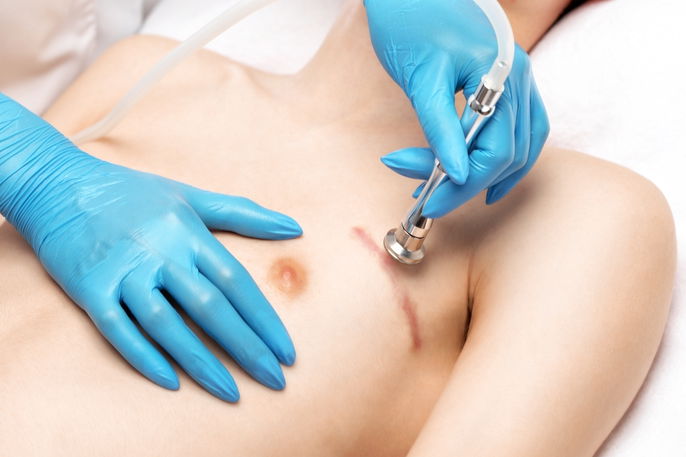Keloid removal may consist of several treatments, and may involve applying ointments, injecting corticosteroids,, applying silicone dressings and, in some cases, excision through a surgical procedure.
A keloid is an abnormal but benign growth of scar tissue that occurs due to increased collagen production. It is likely to appear where the skin has been damaged, which can happen with cuts, surgery, acne and piercings.
Although keloids are not clinically serious, it can be uncomfortable and cosmetically undesired. If you are thinking about keloid removal, speak to a dermatologist or plastic surgeon, who can recommend the best treatment approach for you.

How to get rid of a keloid
The main treatment options for keloid removal include:
1. Keloid ointments
Keloid ointments are an excellent treatment option, as they help to disguise the scar and reduce symptoms like pain and itching. These ointments and creams may contain ingredients like copper, zinc sulfate, fibrinolysin or desoxymethasone, and can be obtained with a prescription.
2. Corticosteroid injection
Injecting a corticosteroid directly into the keloid with solutions like triamcinolone is usually one of the first treatment options for a keloid scar.
These injections are administered by the dermatologist, at intervals of 4 to 6 weeks between each one. They can be done as a stand-alone treatment or used in conjunction with keloid ointments.
3. Silicone dressing
Silicone dressings are a self-adherent, waterproof dressing that must be applied to the keloid for 12 hours at time over a period of 3 months. This dressing helps to reduce the redness of the skin and the height of the scar.
The dressing is applied to clean, dry skin to improve the appearance of the lesion. The dressing can be used during daily activities, and usually can be re-used for up to 7 days.
4. Laser
Laser treatment for keloid removal can help to relieve itching, reduce the size of the scar, and promote skin lightening in the keloid area.
This type of treatment is carried out by applying pulsed dye laser or ndYAG directly to the keloid, causing the destruction of the tissue that has grown in excess. This laser also applies triggers anti-inflammatory response in the area.
Generally, several sessions are required, with intervals of 4 to 8 weeks between each. The laser is generally prescribed by a dermatologist to be used in combination with other types of treatments, such as corticosteroid injections.
5. Cryotherapy
Cryotherapy for keloids is a treatment that can be used for keloid removal or to reduce the size of the keloid. It works by freezing the keloid from the inside out using liquid nitrogen.
Generally, cryotherapy is effective for small keloids and several sessions must be performed by a dermatologist for the effects to be observed.
6. Surgery
Surgery is considered the last option for removing keloids, as it is associated with a risk of new scar formation or even worsening of the existing keloid. This type of surgery should only be done when other treatments have not been effective.
7. Radiation therapy
Radiation therapy for keloids is a type of treatment that uses low-power X-rays directly on the scar, to prevent collagen synthesis and keloid formation.
Generally, this type of treatment is done about 24 to 48 hours after surgical removal of the keloid to prevent or minimize scar formation.
Radiation for keloids can cause some skin complications and even increase the risk for cancer, and should therefore be avoided in areas such as the head, neck and breasts.
How to prevent keloids during healing
To prevent keloid formation during the healing process, it is important to take some precautions, such as using sunscreen every day, protecting the affected area direct sun exposure, and using creams or ointments as prescribed by your doctor.
A dermatologist or plastic surgeon are the best doctors to advise on the prevention of keloids in scars.






























